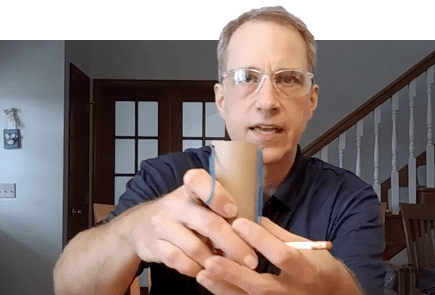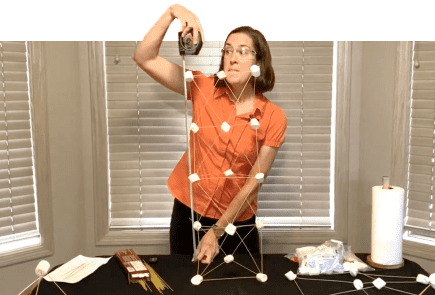Join 3M chemical engineer Jayshree Seth for an at home science experiment. Jayshree demonstrates how to inflate a balloon using common household chemicals like vinegar and baking soda.
Background
You probably know that when you mix certain chemicals together, sometimes strange and amazing things happen. One of the most popular reactions is combining Baking Soda and Vinegar to create a beautiful mountain of bubbles. But have you ever wondered if you can use that reaction to do something useful? In this activity we will explore how we can you a chemical reaction to do some work!
Key Concepts
- Chemistry
- Gases
- Reaction
- Acids and Bases
Materials
- An adult helper
- A balloon
- A funnel
- Clear, empty water bottle (at least 12 oz. or larger)
- Measuring cup
- 1 cup of Vinegar
- 1/4 cup Baking Soda
Preparation
- Measure out 1/4 cup of baking soda
- Measure out 1 cup of vinegar
- Stretch out the mouth of the balloon so it will be easier to fit it onto the mouth of the water bottle
- Place the narrow end of the funnel into the mouth of the balloon so that the balloon hangs underneath the funnel. Carefully pour the baking soda into the balloon. When finished, the balloon should be about half full of baking soda.
- Remove the funnel from the balloon and place the balloon on the table.
- Use the funnel to carefully pour the vinegar into the empty water bottle.
- With assistance from an adult, stretch the mouth of the balloon over the mouth of the bottle. Make sure it is on nice and tight all the way around the mouth of the bottle.
- With one hand holding the water bottle in place, use your other hand to help the baking soda in the balloon to find its way into the water bottle. What do you see happening inside the water bottle? What happens to the balloon?
- Be careful when you remove the balloon from the water bottle. You can have an adult help you. You can pour the liquid solution in the water bottle down the drain with a water rinse.
Observation and Results
Why did the balloon inflate? When you mix baking soda (sodium bicarbonate, NAHCO3) and vinegar (Acetic Acid, CH3COOH) carbonic acid is quickly created. This is what caused the bubbles you saw. Carbonic acid (H2CO3) is very unstable and breaks down into water and carbon dioxide. Carbon dioxide is a gas and needs lots of room, so it rushes into the balloon and fills it up.
There are lots of ways to extend and repeat this reaction. You can turn it into an experiment and modify the inputs to see if you get a different outcome. Here are a couple of variables you might explore. What happens when you change...
The amount of baking soda?
The amount of vinegar?
The temperature of the vinegar?
Remember you only want to change one variable at a time so that you can observe and understand what is happening.
Safety First and Adult Supervision
- Follow the experiment’s instructions carefully.
- A responsible adult should assist with each experiment.
- While science experiments at home are exciting ways to learn about science hands-on, please note that some may require participants to take extra safety precautions and/or make a mess.
- Adults should handle or assist with potentially harmful materials or sharp objects.
- Adult should review each experiment and determine what the appropriate age is for the student’s participation in each activity before conducting any experiment.
Next Generation Science Standard (NGSS) Supported - Disciplinary Core Ideas
This experiment was selected for Science at Home because it teaches NGSS Disciplinary Core Ideas, which have broad importance within or across multiple science or engineering disciplines.
Learn more about how this experiment is based in NGSS Disciplinary Core Ideas.
Engineering Design (ETS)1: Engineering Design
Explore Additional Science at Home Videos and Activities

Feeling Sound
Believe it or not, you can feel sound! Join Gitanjali Rao, former Discovery Education 3M Young Scientist Challenge winner, as she teaches about the frequency of sound and how we perceive pitch.

Make Your Own Cotton-Ball Launcher
What can a rubber band and a cotton ball teach you about potential and kinetic energy?
Join Michael Lewandowski to make your own cotton-ball launcher and find out!

Marshmallow Tower
Have you ever wondered how skyscrapers can be so tall?
Or how people build bridges to span long distances? Explore engineering techniques to build sturdy structures using only marshmallows and uncooked spaghetti.

